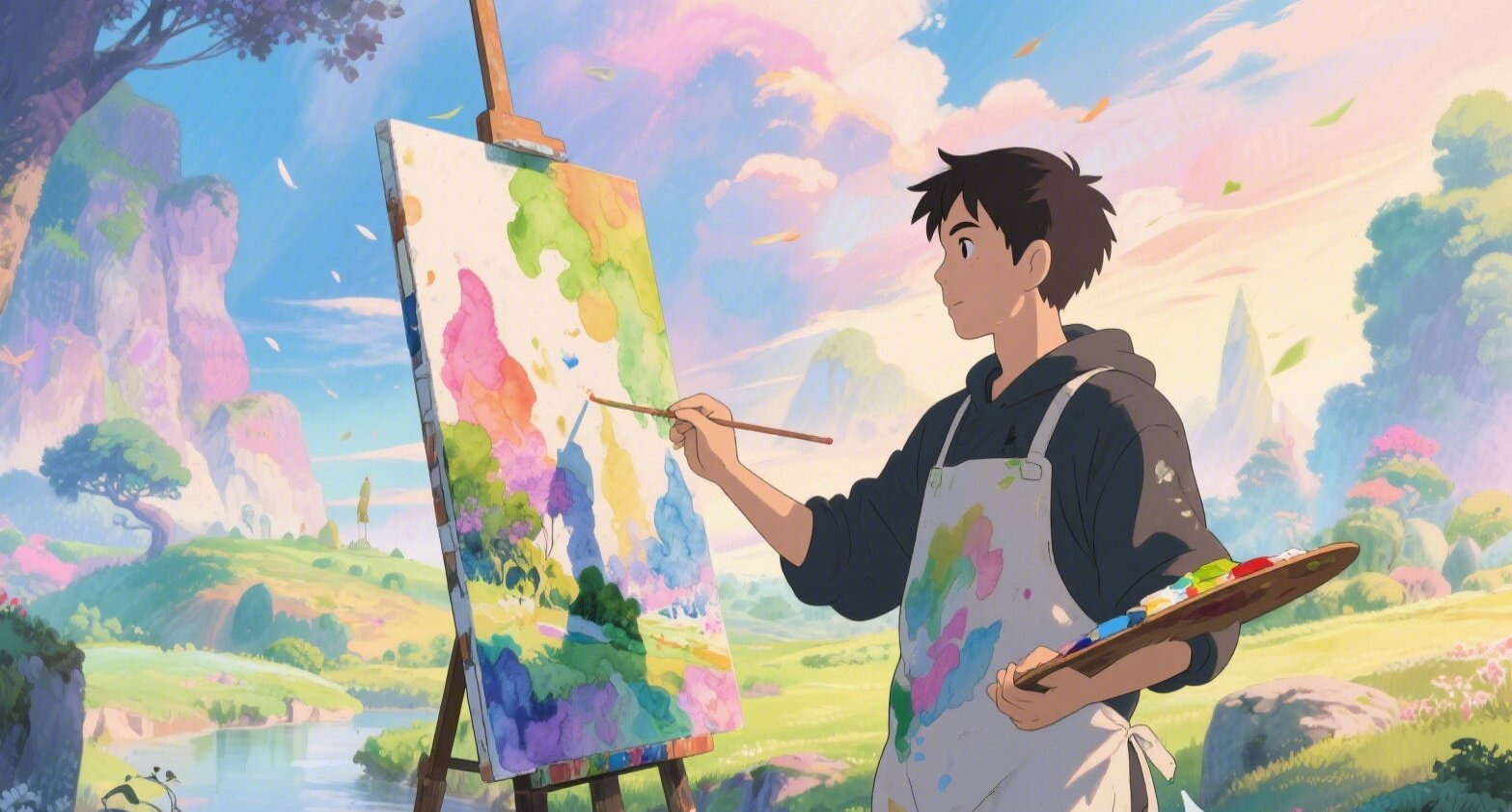Creating animation with the magical quality of Studio Ghibli films has long been a dream for many artists and storytellers. With recent advances in AI technology, creators can now use carefully crafted text prompts to generate images and storyboards that capture the distinctive Ghibli aesthetic. AI Text Humanizer tools have become essential for refining these prompts and ensuring they effectively communicate the desired visual style.
Contents
- The Magic Behind an Effective Prompt for Ghibli Style
- Storytelling Elements in Your Prompt Studio Ghibli Setup
- Using Image to Prompt Technology for Storyboard Development
- Specific Prompt for Ghibli Style Techniques for Different Film References
- Creating Character Design Prompts in a Prompt Studio Ghibli Environment
The Magic Behind an Effective Prompt for Ghibli Style
The perfect prompt for ghibli style contains specific elements that help AI systems understand and recreate the distinctive visual language of Studio Ghibli. This isn’t just about mentioning “Ghibli” in your prompt—it requires understanding the fundamental artistic principles that define this beloved animation studio’s work.
During my animation studies, I spent months analyzing Ghibli films frame by frame. I discovered that an effective prompt for ghibli style needs to address several key components:
- Natural environments with extraordinary attention to detail
- Character designs that balance simplicity with expressive features
- Distinctive lighting effects, particularly dappled sunlight through leaves
- Color palettes that favor certain greens, blues, and warm earth tones
- The interaction between natural and fantastical elements
“The difference between generic anime style and true Ghibli aesthetic is in the details,” explains animation director Hiroshi Tanaka. “When crafting a prompt for ghibli style, I always specify the delicate balance between realism and fantasy that defines Miyazaki’s work.”
Storytelling Elements in Your Prompt Studio Ghibli Setup
Studio Ghibli films are renowned not just for their visual style but for their storytelling approach. Creating a dedicated prompt studio ghibli workspace helps animators and illustrators capture both the visual and narrative elements that make Ghibli stories so compelling.
Character-Driven Narratives
In a well-organized prompt studio ghibli environment, creators develop prompt templates that emphasize character emotions and motivations—a hallmark of Ghibli storytelling.
When I set up my own prompt studio ghibli workspace, I created separate prompt categories for:
- Character emotional states
- Character-environment interactions
- Character transformation moments
- Quiet, contemplative character scenes
These categorized prompt for ghibli style templates help me quickly generate images that capture the character-centered approach of Studio Ghibli.
Environmental Storytelling
Studio Ghibli films often use environments to convey story elements. An effective prompt studio ghibli setup includes references for this distinctive storytelling technique.
Animation student Mai Yoshida shares her approach: “I keep a database of screenshots showing how Ghibli uses environment to tell stories—like how wind moving through grass shows the presence of spirits in ‘Princess Mononoke.’ These references help me craft prompt for ghibli style instructions that include these subtle storytelling elements.”
Magical Realism Techniques
The balance between realistic settings and magical elements is crucial for the Ghibli aesthetic. Your prompt studio ghibli workspace should include tools for achieving this balance.
“The key to a good prompt for ghibli style is understanding how Ghibli introduces magical elements,” notes digital artist Carlos Rodriguez. “They never feel random or out of place—they feel like natural extensions of the world. My prompts always specify this organic connection between magical and mundane elements.”
Using Image to Prompt Technology for Storyboard Development
The animation process typically begins with storyboarding, and AI-assisted storyboard creation has become increasingly popular. Image to prompt technology plays a crucial role in this process, helping creators analyze and refine their Ghibli-inspired storyboards.
Scene Analysis and Refinement
After creating initial storyboard frames with prompt for ghibli style instructions, animators use image to prompt technology to analyze the results.
When storyboarding a short film recently, I generated several key scenes using my prompt for ghibli style templates. I then used image to prompt analysis to identify which scenes truly captured the Ghibli essence and which needed refinement. The technology pointed out that some scenes lacked the characteristic depth of field found in Ghibli compositions, allowing me to adjust my prompts accordingly.
Consistency Checking
Animation requires visual consistency across scenes. Image to prompt technology helps identify inconsistencies that might not be immediately obvious to the human eye.
“Before image to prompt tools, I struggled with maintaining consistent lighting across my Ghibli-inspired sequences,” admits independent animator Zoe Chen. “Now, I run each frame through analysis to ensure my prompt for ghibli style is producing consistent results throughout the sequence.”
Style Transfer Guidance
Some animators use existing footage as reference, and image to prompt technology helps transform these references into appropriate Ghibli-style prompts.
Animation studio director Marcus Williams explains his workflow: “When adapting existing stories to Ghibli style, we use image to prompt technology to analyze both Ghibli references and our source material. This generates detailed text descriptions that we can combine into new prompt for ghibli style instructions that blend the source material with authentic Ghibli elements.”
Specific Prompt for Ghibli Style Techniques for Different Film References
Different Ghibli films have distinctive visual approaches. Advanced creators maintain specialized prompt for ghibli style templates for different film references:
“My Neighbor Totoro” Inspired Settings
Capturing the pastoral charm and gentle fantasy of “My Neighbor Totoro” requires specific prompt elements.
When creating Totoro-inspired settings, I include phrases like “sun-dappled rural Japanese countryside,” “lush summer vegetation with detailed grass textures,” and “saturated greens and blues with warm accents” in my prompt for ghibli style instructions.

“Spirited Away” Magical Environments
The richly detailed spiritual realm of “Spirited Away” needs different prompt for ghibli style specifications.
Digital background artist Akiko Tanaka shares: “For ‘Spirited Away’ inspired scenes, my prompt for ghibli style always includes ‘traditional Japanese architecture with exaggerated proportions,’ ‘rich red accents against earth tones,’ and ‘steam and atmospheric elements that suggest transformation.'”

“Princess Mononoke” Natural Dynamics
The primal, sometimes violent natural world of “Princess Mononoke” requires its own prompt for ghibli style approach.
“Princess Mononoke has a different color palette and energy than other Ghibli films,” notes concept artist Jordan Blake. “My prompt for ghibli style work for Mononoke-inspired pieces includes terms like ‘ancient forest with visible spiritual energy,’ ‘dynamic composition suggesting movement and conflict,’ and ‘muted color palette with selective vibrant accents.'”

Creating Character Design Prompts in a Prompt Studio Ghibli Environment
Character design represents one of the most challenging aspects of Ghibli-style creation. A well-organized prompt studio ghibli workspace includes specific sections for character development:
Age-Appropriate Design Elements
Ghibli characters have age-specific design elements that can be captured in careful prompting.
In my prompt studio ghibli setup, I maintain separate templates for:
- Young children (simplified features, larger heads, emphasizing innocence)
- Adolescents (more detailed features, often during moments of growth or realization)
- Elderly characters (exaggerated features that suggest wisdom and experience)
Each template contains specific prompt for ghibli style language that captures these age-related design principles.
Character Emotion Libraries
Studio Ghibli is renowned for subtle emotional expression. Advanced prompt for ghibli style creators maintain libraries of emotional state descriptions.
“I’ve built what I call an ’emotion thesaurus’ for my prompt for ghibli style work,” says animation director Lisa Wong. “Instead of just saying ‘happy’ or ‘sad,’ I have detailed descriptions of how Ghibli characters express these emotions—the specific eye shapes, mouth positions, and body language that make their emotional expressions so compelling.”
Movement and Gesture Specifications
The way Ghibli characters move tells us who they are. Effective prompt for ghibli style instructions include movement qualities.
When designing a character inspired by “Kiki’s Delivery Service,” I included specific movement descriptors in my prompt for ghibli style: “character shows determination through forward-leaning posture” and “hair movement suggests both wind and inner emotional state.”


